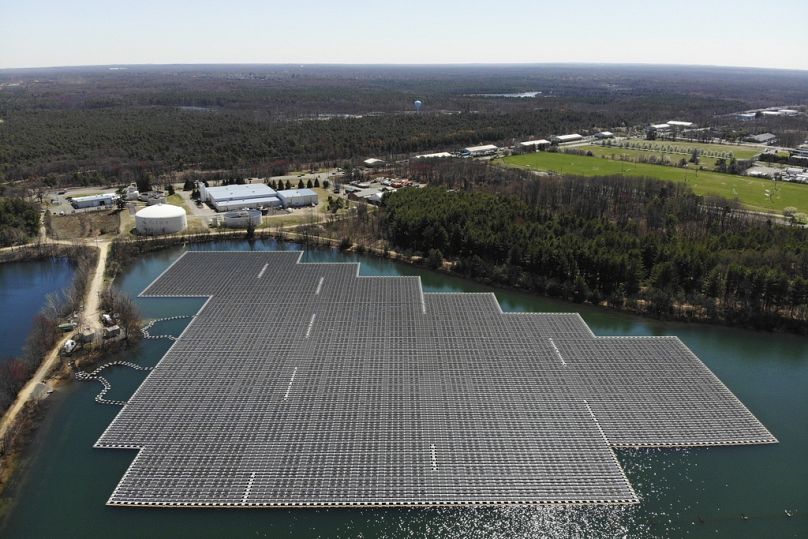This technology is already popular in Asian countries where free land is scarce and expensive but now it is taking off in other parts of the world.
Producing electricity uses up huge amounts of land and often generates vast quantities of climate-heating emissions.
But what if it didn’t need to?
Floating solar panels are a simple concept but they could provide the answer to these problems - and prevent water loss from evaporation at the same time.
Photovoltaic cells are attached to rafts on bodies of water instead of taking up land that could be used for agriculture or buildings. They act as a sort of lid too, reducing evaporation to almost zero - a bonus in areas frequently hit by drought.
And, because the water keeps the solar panels cool, they can produce more energy than they would on land where they become less efficient as they heat up.
Having already boomed in popularity across Asia, now the number of installations like this is growing in the US.
Floating solar is seeing a boom in the US
Chris Bartle is director of sales and marketing for floating solar company Ciel & Terre, which has already built 270 projects in 30 countries.
“Asia, especially island nations like Japan and Taiwan, were very keen on floating solar because they just didn't have a lot of land for large scale ground mount solar. So that's been our fastest-growing market and continues to be our fastest-growing market,” he says.
He adds that limited space on land is now driving other countries to consider this technology too.
“Here in the US where we have more land, what we're seeing is where we have population density islands in California, in the Northeast and Florida, those are the hot markets here in the US where again they don't have land or land is very expensive,” Bartle explains.
One of the biggest floating solar farms in the US was built by Ciel & Terre in Healdsburg, California. It generates 4.8 MW of power - enough for roughly 3,400 homes.
Another farm, nearby in the town of Windsor, was installed four years ago on top of a wastewater treatment plant.
“You're looking at a wastewater treatment pond,” Bartle says as he stands in front of the facility.
“And behind me, you'll see a 1.8 MW floating solar system that Ciel & Terre built about three or four years ago. One of the first ones here in California, one of the first over a megawatt here in California.”
Floating solar still has some problems that need to be fixed
Floating solar isn’t a perfect solution, however. The technology can’t operate on fast-moving water, the open ocean or on shorelines with big waves.
Deep water can increase installation costs too, and it is already more expensive than on land installation. But, while floating solar costs around 10 to 15 per cent more initially, Bartle says that owners will save money in the long run.
Engineers are also working on other challenges. If too much of the surface of a body of water is covered, dissolved oxygen levels can change and water temperatures drop, causing problems for aquatic life.
There’s ongoing research into whether electromagnetic fields generated by cables negatively impact aquatic ecosystems, but there’s no evidence of this yet.
In March, a study published in the journal Nature Sustainability found that thousands of cities - more than 6,000 across 124 countries, could generate all of their power from floating solar. If they made the switch, it calculated that they’d also save roughly enough water each year to fill 40 million Olympic-sized swimming pools.
Watch the video above to learn more about the boom in floating solar farms.












